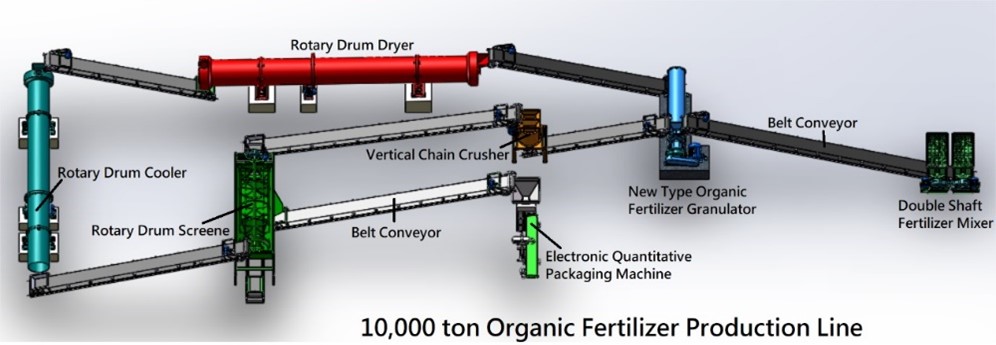The current commercial projects of organic fertilizers are not only in line with economic benefits, but also in line with the guidance of environmental and green agricultural policies.
Reasons for the organic fertilizer production project
The source of agricultural environmental pollution:
the reasonable treatment of livestock and poultry manure pollution can not only effectively solve the environmental pollution problem, but also turn waste into treasure and generate considerable benefits. At the same time, it also forms a standardized green ecological agricultural system.
The organic fertilizer project is lucrative:
The global trend of the fertilizer industry shows that safe and environmentally friendly organic fertilizers can maximize crop yields and minimize the long-term negative impact on the environment’s soil and water. On the other hand, organic fertilizer has huge market potential as an important agricultural element. With the development of agriculture, the economic benefits of organic fertilizer have gradually become prominent. From this perspective, it is profitable and feasible for entrepreneurs/investors to develop organic fertilizer business.
Government policy support:
In recent years, the government has provided a series of policy support to organic agriculture and organic fertilizer enterprises, including target subsidy market investment capacity expansion and financial assistance to promote the widespread use of organic fertilizer.
Awareness of food safety:
People are becoming more and more aware of the safety and quality of daily food. The demand for organic food has continuously increased in the past decade. The use of organic fertilizers to control the source of production and avoid soil pollution is the foundation of food safety.
Abundant organic fertilizer raw materials:
A large amount of organic waste is generated every day around the world. According to statistics, there are more than 2 billion tons of waste every year in the world. The production of organic fertilizers from raw materials is abundant and extensive, such as agricultural wastes, rice straw, soybean meal, cottonseed meal and mushroom residues, livestock and poultry manures such as cow manure, pig manure, sheep and horse manure and chicken manure, and industrial waste materials such as distillers’ grains, vinegar, residues, etc. Cassava residue and sugar cane ash, household garbage such as kitchen food waste or garbage, etc. It is precisely because of the abundant raw materials that the organic fertilizer industry is able to flourish worldwide.
So how to convert waste into organic fertilizer and how to develop organic fertilizer business is very important for investors and organic fertilizer producers. Here we will discuss the issues that need to be paid attention to when starting an organic fertilizer project from the following aspects.
Four major problems in starting an organic fertilizer project:
◆High cost of organic fertilizer
◆Difficult to sell in the market
◆Poor application effect
◆Improper homogeneous competition market
A comprehensive overview of the suggested countermeasures for the above organic fertilizer project problems:
◆ High cost of organic fertilizer:
Production cost” Fermentation main materials, fermentation auxiliary materials, strains, processing fees, packaging, and transportation.
* Resources determine success or failure “Competition between cost and resources” Build factories nearby, sell nearby places, reduce channels for direct supply of services, and optimize and simplify process equipment.
◆ Difficult to sell organic fertilizer:
* Small profits but quick turnover + characteristic demand. The competition between quality and effect. Product function meets (organic + inorganic). Professional training of the business team. Large agricultural themes and direct sales.
◆ Poor application of organic fertilizer:
General functions of fertilizers: fix nitrogen, dissolve phosphorus, depot potassium, and dissolve silicon.
Source of raw materials and content of organic matter > Small-molecule quick-acting organic matter decomposes quickly and fast fertilizer effect is good > Medium-molecular slow-acting organic matter decomposes slowly and fertilizer efficiency is slow > Large molecule long-acting organic matter decomposes slowly and fertilizer efficiency is poor.
* Fertilizer specialization and functionalization 》According to the soil conditions and the nutrient needs of crops, scientifically mix fertilizers such as nitrogen, phosphorus, potassium, trace elements, fungi, and organic matter.
◆ Improper homogeneity competition market:
* Be fully prepared “Relevant registration license, management system certification, provincial-level related award certificates, test certificates, paper patents, bidding results, expert titles, etc.
Specialized equipment and display on tall.
The government’s policy is coordinated with the large agricultural households to move around and get close.
How to choose a site for organic fertilizer production:
Site selection is very important and is directly related to the raw material capacity of organic fertilizer production. There are the following suggestions:
The location should be close to the supply of raw materials for organic fertilizer production to reduce transportation costs and transportation pollution.
Try to choose areas with convenient transportation to reduce logistics and transportation costs.
The proportion of the plant should meet the requirements of the production process and reasonable layout, and appropriate development space should be reserved.
Keep away from residential areas to avoid more or less special odors that affect the lives of residents during the production of organic fertilizer or the transportation of raw materials.
The site selection should be flat terrain, hard geology, low groundwater level, and good ventilation. In addition, avoid places prone to landslides, floods or collapses.
Try to choose in line with local agricultural policies and government support policies. Make full use of idle land and wasteland without occupying arable land and try to use the original unused space as much as possible, so that investment can be reduced.
The plant area is preferably rectangular. The factory area is about 10,000-20,000 square meters.
The site cannot be too far away from the power line to reduce power consumption and investment in the power supply system. And close to the water source to meet the needs of production, life and fire fighting water.
All in all, the materials needed for the production of organic fertilizer, especially poultry manure and plant waste, should be obtained from nearby farms and pastures, such as “breeding farms”, and other convenient places.
Disclaimer: Part of the data in this article comes from the Internet and is for reference only.
Post time: May-13-2021


